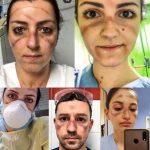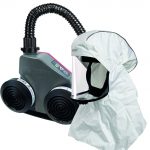As the Coronavirus pandemic continues, we’re seeing more healthcare professionals being affected mentally and physically. Their primary concern is helping others, but their painful respirators are now adding strain to doing their job.
Healthcare workers on the frontline are scared for their own safety in the fight against Coronavirus. They are in desperate need for PPE that’s going to protect them from contracting the virus.
N95 face masks are the most popular protective face mask available because they can be manufactured quickly and they provide what’s deemed as adequate levels of protection.
Tight-fitting face masks that cover the nose and mouth do have their advantages. When worn with a P3 filter, they offer the highest level of respiratory protection; they’re fairly inexpensive and can be re-used, eliminating wastage.
Painful Respirators
Face masks are not designed to be worn for prolonged periods of time. They’re called tight-fitting, so after a while, they’re going to hurt and leave a painful imprint across the nose bridge, under the chin and across the cheekbones.
Tight-fitting masks are made of plastic or rubber materials, so after a while, the skin will start to sweat. If left unexposed to the air, the skin will become clammy and sore.
The news is full of doctors and nurses posting selfies after their gruelling shifts of their bruised faces
The bruises are left by the protective masks that healthcare workers must wear for numerous hours at a time to protect themselves and others. Whilst they safely treat people suffering from the highly contagious disease, they feel they have no alternative choice.
However, there is a comfortable alternative that provides the ultimate level of protection.
Powered Air Respirators
The alternative is a loose-fitting head top with a powered air system. Consisting of 4 main components (head top, hose, filters & battery/pump pack), they provide cool and filtered air around the face.
There are no pressure points on the face so loose-fitting respirators leave no facial markings. They’re lightweight too so they sit over the head comfortably.
These respirators are much more comfortable to wear than a tight-fitting face mask. If worn comfortably, caregivers are much more likely to gain the full benefit of the protection they provide.
The head top has a large visor so vision isn’t impaired yet provides protection to the whole of the face. The FH2 and FH21 head tops cover the neck and shoulders for total coverage.
Some doctors prefer the FH1 head top as it doesn’t cover their ears so they can still use their stethoscopes.
How Do They Work?
A lightweight pack which contains the battery and P3 filters are worn on the waistband. Purified air is pumped via a hose to the head top.
They’re unobtrusive so the worker can get on with treating their patients easily.
The real benefit in these respirators is that they’re comfortable to wear. The face does not sweat because cool purified air continually circulates around the head top. There are no pressure points so the wearer is not left with any sore skin markings.
So wearing a loose-fitting respirator eradicates any painful dread that so many of our healthcare professionals are faced with on a daily basis.
Why aren’t all hospital trusts buying these?
Whilst loose-fitting respirators provide the most wellbeing benefits to the wearer, they do have an element of maintenance. At the end of a shift, the battery will need recharging and the unit will need disinfecting so it can be passed to the next person to wear.
These systems are more expensive to purchase but once cleaned, they can be shared amongst co-workers. Therefore the cost per worker makes them more affordable.
We appreciate that individual workers will want their own headtop not only for personal hygiene but for usability too. Some might want a face covering, yet others require total neck and shoulder coverage.
Our Suggestion
1 head top per healthcare worker
1 respirator system per 3/4 workers (depending on shift length and pattern)
Consider purchasing extra battery packs to reduce downtime and allow for continued use.
Because they’re designed to be worn over a long shift, they’re available with two battery pack options – standard (up to 8 hours life) and extended battery (up to 16 hours).
The battery pack has a visual indication of how much power is left and alarms as a reminder once the battery needs changing.
Read our handy guide – 5 Things You Need to Know About Powered Air
To protect your healthcare workers and the thought of wearing painful respirators, consider buying these loose-fitting respirators. They’ll make a huge difference to workers’ wellbeing.
Since the beginning of March, a1-cbiss has supplied hundreds of Duraflow and PX4 respirators to the UK’s biggest hospitals.
Contact us for more information or to see how we can support you







